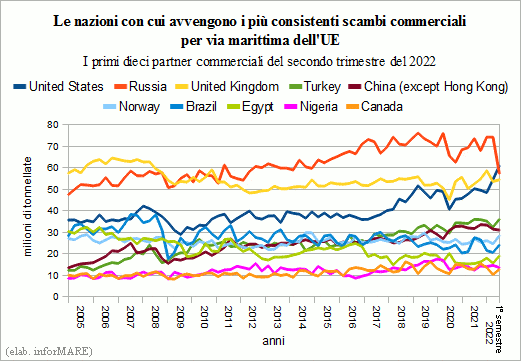
In the second quarter of last year, the United States become the European Union's first trading partner with regard to goods traded by sea having bypassed the Russia. The latest statistical data from Eurostat show that in the Maritime traffic between the US and the EU was equal to 61,0 million tons, with a strong increment of +21.1% on the second quarter of 2021. If in the first quarter of 2022 the maritime trade between the EU and Russia was still the most important substantial, with 74.4 million tonnes traded compared to 54.7 million tonnes of traffic between the US and the EU, in the period April-June last year sea transport between Russia and the European Union amounted to 57.5 million tons, with a decrease - the first in four consecutive quarters of growth - -22.1% on the second quarter of 2021.
In the second quarter of last year, a period in which ports of the European Union have enlivened altogether 872,9 million tons of goods (+2.2%), the other main partners EU sea trade turned out to be the UK (54,6 million tons, +3.6%), Turkey (36,2 million tonnes, +0.1%), China (31.2 million tonnes, -2.1%), the Norway (28.5 million tons, +5.0%), Brazil (24.2 million tons, -12.6%), Egypt (19.1 million tons, +22.9%), Nigeria (13.6 million tons, +9.8%) and Canada (12.9 million tons, -0.3%).
In addition to the one with Russia, in the second quarter of 2022 the the largest decline in EU maritime trade was the one with Brazil (-12.6%), while the most the increase with Egypt (+22.9%) followed by the one with the USA.
In the second quarter of last year 17 of the 20 most substantial volumes of goods handled by European ports were in import and three export. The latter were substantial in rolling stock bound for the United Kingdom (11 million tonnes) and in containers bound for China (eight million tons) and ports the east coast of the USA (seven million tons). The The first three import trade flows consisted of containers from China (16 million tons), from crude oil from ports on the east coast of the States United (10.4 million tons) and petroleum products from Russian ports on the Baltic Sea (10.4 million tons).
Among the goods entering the EU, the largest Quantitative was found to be by far that of liquid bulk, but significant quantities were found to be also those of containers from China, of coal from east coast of the USA and Australia, minerals and products agricultural from Brazil and ro-ro cargo from the Kingdom United.
